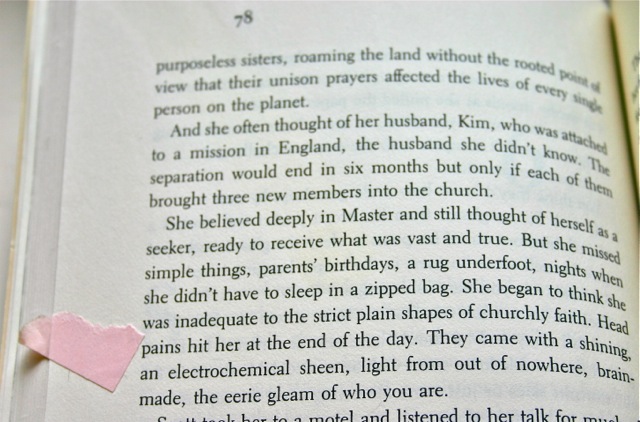Notes from My Dashboard
Guest post by Greg Schutz
“Writing a novel,” E.L. Doctorow has observed, “is like driving a car at night. You can see only as far as your headlights, but you can make the whole trip that way.”
For me, at least, the same could be said about writing short stories. Perhaps my headlights just don’t reach as far as Doctorow’s. In any case, whatever I can offer in this post by way of “advice” is really just a description of how I work. These are some notes I keep taped to the dashboard when I’m driving at night.
A further disclaimer: As writers, many of you have a great deal more experience, and have enjoyed a great deal more success, than I have, in which case I’m probably telling you little that you haven’t already discovered for yourself. You have your own notes taped to your own dashboards, your own highways, the dark landscapes of your own narratives flowing past your windows. Still, whether veterans or newcomers, we’re all dealing with the same basic challenges of language and narrative. It can’t hurt, now and then, to compare notes.
Craft can be counterproductive. I’ve already registered my suspicions about how-to advice on the craft of writing in a previous post. One problem with the axioms (“show, don’t tell”) and diagrams (Freytag’s triangle, below) of craft is that they turn the act of writing on its head. Freytag’s triangle, for example, is much more effective as a tool of analysis than one of instruction. It can be useful to study a completed story through the lens of the triangle. However, when taken as instruction, Freytag’s triangle, like most craft advice, is more hindrance than help. Like a cookie-cutter, it stamps the uncooked dough. The resulting story, built to satisfy preconceived notions of craft, is likely to have about the same resemblance to real life as a gingerbread man has to a living, breathing person.
There’s a time, no doubt, for conscious craft–a time, in other words, to regard the story you’re writing as a story, heir to (and, hopefully, in one way or another, willful transgressor of) the traditions and expectations of its form. But for me, at least, that time does not arrive until after the first few drafts have been completed. During those drafts, the story is still more dream than brick-and-mortar reality. I may not write in a phrensy, but I do grow suspicious of early drafts that feel too much like connect-the-dots, the realization of predetermined shapes. First drafts in particular ought to be more improvisational, playful, associative, dreamy. At this point, the story shouldn’t be like a pre-shaped cookie baking, but rather like a cloud assuming–slowly, tantalizingly–a recognizable form.
Plot can be selective. It’s easy to grow suspicious of plot. The first half of the twentieth century, for example, witnessed the modernist “plot against plot,” which was based, as novelist and critic Lev Grossman writes, on the notion that “stories were a distortion of real life.” This critique echoes my suspicions about Freytag’s triangle, that hieroglyph of plot. Do our lives organize themselves around single discrete conflicts, conflicts which are developed through rising actions, resolved through climaxes, and clarified through denouements? Real life is much more confused–and confusing–than this. Given the enormous, vital mess we encounter every day, a perfectly plotted story risks feeling antiseptic, schematic, lifeless.
One problem with this critique, however, is that it treats plot as an intrusive force, an artificial imposition made by the author upon the lives of her characters. Yet this is not necessarily the case.
Plot does not have to operate as an imposition from without; in fact, it may be more constructive to think of it as a principle of selection operating from within the story. Rather than forcing characters’ lives into the contrived arrangements of shapely narratives, the author is responsible for selecting events for portrayal from within characters’ lives–events selected in order to illuminate certain aspects of those characters’ lives.
This difference is more than just semantic; in fact, approaching plot as an internal principle of selection rather than an external, controlling force may expand the limits–structural, chronological, thematic–of the stories we tell. Consider the sprawling stories of those authors whom I’ve habitually referenced in these posts: Alice Munro, Mavis Gallant, Peter Taylor. Gallant’s plots, for example, rarely coalesce around discrete problems or traditional, clear-cut conflicts; rather, her stories draw their shapes from the efforts of a narrative intelligence–the author’s or a narrator’s–that selects and arranges events from within (and often throughout) characters’ lives.
Furthermore, this way of thinking about plot that leads us away from Freytag’s triangle and other cookie-cutter narrative shapes and toward more idiosyncratic, organic structures. It offers complexity without contrivance.
Language can be generative. In his classic work The Art of Fiction, John Gardner discusses at length a variety of ways in which what he calls “the fictional dream” makes demands on the author’s language. Here is an exemplary passage:
If the writers says “creatures” instead of snakes, if in an attempt to impress us with fancy talk he uses Latinate terms like “hostile maneuvers” instead of sharp Anglo-Saxon words like “thrash,” “coil,” “spit,” “hiss,” and “writhe,” if instead of the desert’s sand and rocks he speaks of the snakes’ “inhospitable abode,” the reader will hardly know what picture to conjure up on his mental screen.
This is all good advice, as far as it goes. But The Art of Fiction fails to offer the same depth of analysis to the ways in which language, in turn, affects the fictional dream. Language is, in fact, generative: It spins the fictional dream off into new and often unanticipated directions. Every word you choose, every sentence you build, affects your next word, your next sentence.
Because this is my final post and I have nothing to lose, I’ll risk some examples from my own work. In “Joyriders,” my story from the fall issue of Ploughshares, a young sheriff’s deputy named Jimmy Barnes leaves a mug of coffee on the roof of his car as he drives off from a gas station, only to realize his mistake several hundred yards down the road. He gets out of the car and “combs the beam [of his flashlight] through the roadside weeds”–knowing, of course, that he’s not going to find what he’s looking for. Several pages later, Doc, a veterinarian, watches as Barnes “shifts from foot to foot and combs his teeth over his lower lip.”
By using a single word–combs–in two distinct contexts (in the first, Barnes is bewildered, self-flagellating, lost; in the second, Doc mistakenly sees in Barnes “the impatience and studied professional sympathy of officialdom”), I hoped to create an echo that highlights the story’s use of dramatic irony. The appearance of “crumpled” dollar bills twice in the story is similarly intentional. I did not initially choose “combs” or “crumpled” with any intention of echoing them again later. And yet the words offered–down the line, as I made my revisions–opportunities I couldn’t have foreseen.
Sentence structure, too, can be generative. For example, my ear told me at one point as I wrote the scene in which Barnes searches the ditch for his lost mug, that, rhythmically, I needed a longer sentence. I wrote, “Barnes, Jimmy Barnes thinks, considering himself as if from afar–a skinny young man caught in the cone of deep shadow behind his flashlight, his shoes rapidly losing their shine in the muddy grass–is a fool.”
This sentence, with Barnes struggling to study himself from without even as he is indelibly trapped within, provided me my first glimpse–before I even knew what I was looking for–of my story’s theme. If I hadn’t written this sentence–if my ear hadn’t alerted me to the need for a longer sentence, one with nested clauses–I may have written a different story entirely.
Sometimes, the nose knows. The above sentence was fun to write, but when I looked back on it I found myself wondering if it wasn’t too ornate for its task. The sentence could easily have perished during revisions. More than once, I considered trimming it significantly or even cutting it entirely. In the end, however, I did neither. Ultimately, I remained convinced that the sentence had a purpose in the story–and, significantly, I was convinced of this even before I knew what that role was.
Call it instinct, if you’d like. Call it a gut feeling. This, as I take it, is part of what Flannery O’Connor was talking about when she described “the habit of art”: a subconscious sense for what is and is not working in a story, a trustworthy intuition that springs into action long before the conscious mind begins to perform its analyses. Just as I knew, without having to pause and deliberate, that the sentence worked rhythmically, I also knew, on some level, that its structure was necessary. It just took a while before I could explain why.
Sometimes, the nose knows.
And if intuition is vital to the act of writing itself, it is no less essential after the story has been sent out into the world. “Joyriders” was rejected more than twenty times before it found a home in Ploughshares. And yet none of those rejections shook my faith that the story was essentially complete and largely successful at what it intended to do. From the start, I was confident that it would find a home. I couldn’t have said why. I simply had a good feeling about it–and that feeling was all the more powerful, all the more sustaining to me through those initial waves of rejections, because I couldn’t just explain it away.
This is Greg’s sixteenth and final post for Get Behind the Plough.


